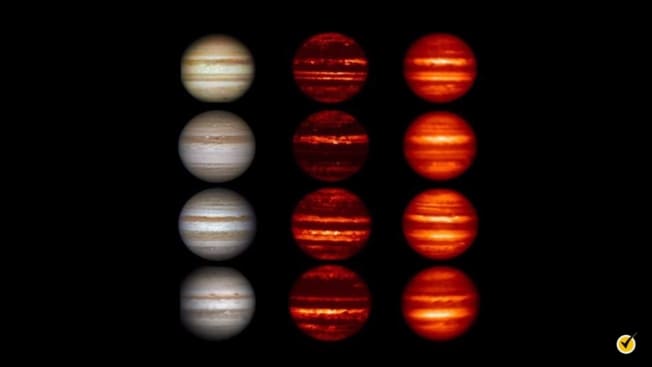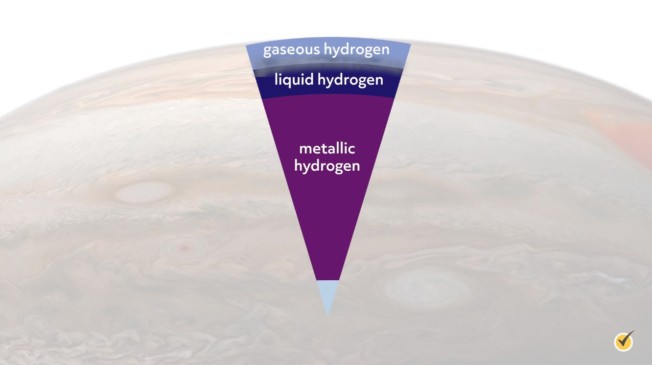
This image shows the size of the giant planets relative to each other and to the terrestrial planets. Keep in mind that this image does not accurately show the large distances between these planets in space.

At the left edge, the Sun is included for size comparison. Then, from the left, you are seeing the four terrestrial planets (Mercury, Venus, Earth, and Mars), and then the four giant planets (Jupiter, Saturn, Uranus, and Neptune). Pluto is at the far right. Put next to each other like this, you can clearly see why Jupiter, Saturn, Uranus, and Neptune are called the giant planets.
Beyond size, the giant planets have some other traits in common. They are all low-density and composed of hydrogen, helium, and hydrogen compounds. They all have rings and multiple moons, strong magnetic fields, and no solid surface.
Jupiter
First, let’s learn about Jupiter—the largest planet in our solar system.
This image, taken by the Juno spacecraft currently in orbit around Jupiter, shows Jupiter’s clouds. You can see many storms and eddies as circles and swirls. What powers Jupiter’s complicated weather?

The weather on Jupiter is powered by heat in combination with Jupiter’s rotation. The most obvious aspect of Jupiter’s atmosphere are stripes caused by patterns of rising and sinking air. The light bands in Jupiter’s atmosphere are the result of clouds that rose and cooled.
They are at a higher altitude than the darker bands. The lower, darker-colored bands are the result of air that is sinking. This air will heat as it sinks due to the increasing air pressure.

Take a look at these images of Jupiter. The two right columns show Jupiter in the infrared. Infrared light shows where there is more heat, so things that are bright in the infrared image are warmer. You can see that the dark bands in the visible image correspond to the bright glowing bands on the infrared images, confirming that they are warmer than the light colored bands.
Summarizing, the dark stripes are low-altitude warm clouds, and the light stripes are high-altitude cool clouds.
Jupiter is also known for its storms, particularly the large swirling cyclone known as the Great Red Spot. This storm, spotted in 1665 and perhaps even earlier, could currently fit about one-and-a-half to two Earths across its diameter, although it is still changing in size and nature. The storms of Jupiter are partially fueled by its fast rotation rate; a day on Jupiter is only nine hours and fifty minutes long on Earth.
Jupiter’s atmosphere is almost entirely hydrogen. Moving past Jupiter’s atmosphere toward its interior, we find that this “gas giant” is mostly liquid. Often, people wonder what you might encounter on a world with no solid surface. If we were to descend into Jupiter, the atmosphere would get thicker and thicker until the fog around us was mostly liquid.
If we kept descending, we would find a form of hydrogen called liquid metallic hydrogen. This is a state of hydrogen where the atoms are so close together that they share their electrons freely.

If we kept going toward the center of Jupiter, we would eventually find rocks and metals. These are in liquid form due to the high pressures in the center of Jupiter. First we would encounter liquid rocks, commonly called magma. Continuing to the core of Jupiter, this is where we would find elements such as liquid iron, which is also present in the Earth’s core.
Jupiter’s core contains enough liquid rock and metal to form a terrestrial planet larger than the Earth. Why, then, is Jupiter not a terrestrial planet? It comes down to density and composition. Since it is mostly made of hydrogen, even though its core is the size of the Earth, Jupiter is significantly less dense and has a fundamentally different composition.
Hydrogen is the lightest gas there is. It can easily escape a planet’s gravity, so any planet would have a difficult time securing a massive hydrogen atmosphere. But the giant planets did just this! How? When the solar system formed, there were four kinds of materials available to construct planets from: metals, rocks, ices, and gases.
Metals include iron and nickel. Rocks are silicate minerals such as we have on the surface of the Earth. Ices include the frozen state of materials like water and carbon dioxide. Gases refer to those materials that are vapors in most conditions: hydrogen and helium.
Close to the Sun, where the terrestrial planets are found, the Sun’s heat prevents ices from forming. Gases like hydrogen can only be attracted to a very big planet, but with rocks as the only possible building material, warm terrestrial planets never got big enough to attract hydrogen.
A little farther away from the Sun, the temperature drops low enough that ices can form. This location is called the frost line. Any planets constructed past this line can form from rocks and ices. This frost line runs between the coldest terrestrial planet–Mars–and the warmest giant planet–Jupiter.
Jupiter first formed as a terrestrial planet larger than the Earth, made of rocks and ices. Its large size meant it was now able to hold on to a hydrogen atmosphere as well. The large terrestrial planet became hidden as a molten ember–Jupiter’s core–under massive layers of liquid and gaseous hydrogen.
Whatever hydrogen Jupiter missed was captured by Saturn, making it the second largest planet. Uranus and Neptune are smaller than Jupiter and Saturn because, at their extreme distance from the Sun, hydrogen particles are very spread out. This means these planets could not capture this hydrogen over their long orbits. Today, that leaves us with two distinct kinds of giant planets: gas giants and ice giants.
Just like Jupiter, Saturn has stripes caused by alternating warm and cool clouds. Saturn also has storms like Jupiter, as well as a fast rotation rate of ten hours and nineteen minutes. Both the banding and the storms on Saturn are less visibly dramatic than those seen on Jupiter, but their causes are the same. Saturn’s atmosphere is likewise mostly hydrogen, and its interior structure is much like Jupiter’s, though its liquid metallic hydrogen layer is smaller.
Jupiter and Saturn are a lot alike, and they don’t look very different in size, but they have very different masses. Saturn only has about one-third the mass of Jupiter, but it’s not one-third the size. The reason Jupiter is not three times the size of Saturn is that the gas and fluid within Jupiter is compressible, so it compresses under the increased gravity of Jupiter. Under high pressure, gases will turn into liquid and then take up even less space.
Saturn
All four giant planets have rings, but Saturn is particularly known for its rings. They are made of rock and ice varying in size from a fine-grain of sand to a large house.
The rings of Saturn have flattened out, the same way pizza dough flattens when someone tosses and spins it. In fact, Saturn’s rings are so flat that they disappear when viewed from the side. The rings have a great deal of structure, including dark spaces where there are fewer ring particles.
Many of the gaps within the rings host tiny moons called moonlets. These gaps are empty because the moonlets sweep away ring particles. These kinds of moonlets are also called “shepherd moons” because they are herding the dust particles into narrow orbits.
Though Jupiter and Saturn are similar to each other, they appear very different from the other two giant planets–Uranus and Neptune. On Uranus and Neptune, hydrogen is mostly combined into molecules with other elements, forming compounds.
The most common compounds on Uranus and Neptune are methane, ammonia, and water. The blue color of these two planets is due to the methane in their atmospheres. On Uranus and Neptune, these hydrogen compounds exist in liquid, solid, and gaseous forms.

Uranus and Neptune
Of the two ice giants, Uranus is closest to the Sun. Uranus is tilted on its side, meaning its poles are close to the plane of the solar system. This results in odd seasons. One side of Uranus is exposed to the Sun all the time for 21 years, while the other side experiences 21 years of darkness.
Looking in visible light at Uranus, it is a pale blue with no strong evidence of bands, clouds, or storms.
An infrared image of Uranus looks somewhat different. There are bands and storms on Uranus, but this weather is happening in wavelengths we can’t easily see. The weather also appears concentrated on the side of Uranus that we don’t often see. In this image, you can clearly see that Uranus does indeed have rings. The white spots around Uranus are some of its largest moons.

Neptune is sometimes considered Uranus’s twin because they are almost the same size and they both have a similar blue color due to methane. Neptune does not have an extreme tilt, though, so it has weather patterns more similar to those seen on Jupiter and Saturn. Neptune lacks the obvious banding seen on Jupiter and Saturn, but does show white and dark stripes as well as large storms.
The storms on Neptune appear as dark spots and only last a few years. While Neptune does have rings, they are difficult to see, as they are very dark and thin. Additionally, Neptune is the only planet in our solar system which can never be seen with the naked eye.
In summary, the colder temperatures these planets experience farther from the Sun allowed the giant planets to capture ices and hydrogen. Since this meant they had extra materials from which to form, they were able to become much larger than the terrestrial planets. Jupiter and Saturn are very similar, and Uranus and Neptune are very similar. All four planets have rings, moons, and magnetic fields.
That’s all for this review! Thanks for watching, and happy studying!
